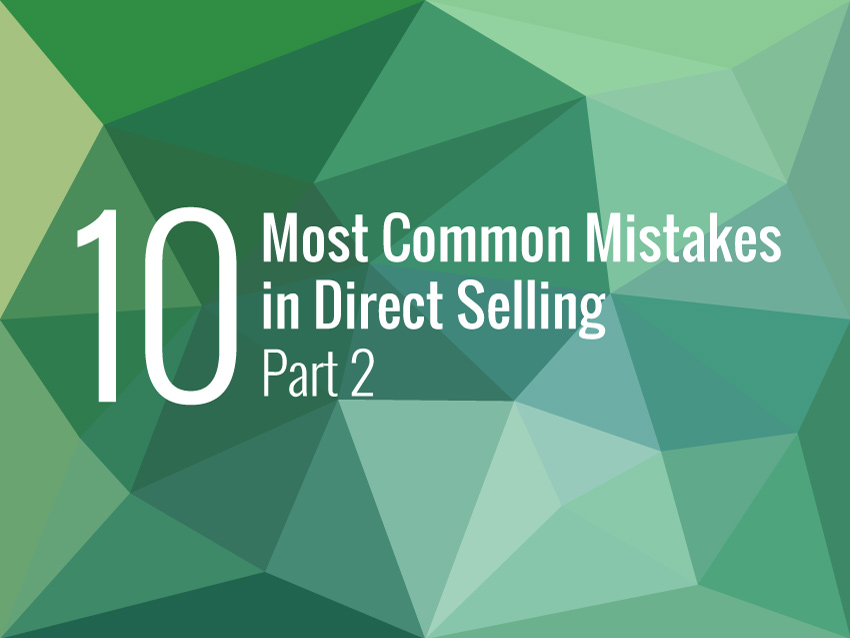The 10 Most Common Mistakes in Direct Selling Part 2
by Dan Jensen
#2: The Wrong Business Model
The world of direct selling has a variety of business models. The model you choose will determine the type of compensation strategy you employ, how you sell your product, and how you grow the business. For example, Avon’s business model relies mostly on retail sellers using catalogs to sell their products to customers. Melaleuca and Arbonne, instead, have thousands of customers who signed up as distributors to buy their products at a substantial discount off retail. They have few people buying their products at the full retail price. Pampered Chef and Tupperware rely extensively on the home party to demonstrate their products to customers.
These three examples of different business models for direct selling have a profound effect on every aspect of how their business is operated. It will be the same for you. Choose your model wisely! It’s one of the first decisions you will need to make. That decision determines your method of selling, your compensation plan, your product pricing strategies, your marketing strategy, the growth rate of your business, your training systems, and your internal operating procedures.
#3: Poorly Designed Compensation Plan
A compensation plan that fails to motivate distributors can become a brick wall to the growth of your company. Some people believe that the greatest key to success is a good compensation plan. While there is some truth to this, I have also observed a few successful companies reach very enviable sales volumes with poorly designed compensation plans. But the truly successful companies always have a sound compensation plan.
At the heart of the issue is the question what makes a compensation plan good? Let’s address a few points:
Reasonable compensation percentages. Most compensation plans of today pay between 25% to 45% of company income to field distributors. If a company promotes a plan paying only 20% or so,
they may have a hard time recruiting and keeping distributors. They may find great difficulty competing in the marketplace against other direct selling companies.
How much can you afford?
Look at the table below (an expanded version is found at www.danjensen-consulting.com). If your markup from your product cost to your retail price is 500% (5x) and a distributor makes 25% for selling the product (retail profit), it shows that you should be able to pay about 28% of wholesale (wholesale is revenue to the company on the sale of each product to a distributor exclusive of tax and freight).
| 3x | 4x | 5x | 6x | |
|---|---|---|---|---|
| Retail Price | $100 | $100 | $100 | $100 |
| Wholesale | $75 | $75 | $75 | $75 |
| Retail Profit to Distributor | $25 | $25 | $25 | $25 |
| Upline Payout | $15 | $18 | $21 | $24 |
| Upline Payout as % of the $75 | 20% | 24% | 28% | 32% |
| Product Cost | $33 | $25 | $20 | $17 |
| G&A Expenses | $15 | $15 | $15 | $15 |
| Profit | $8 | $13 | $15 | $15 |
Be sure you know the true long-term cost of your compensation plan before you announce it. Your estimate of the percent of sales you will pay out should be done at “maturity”, usually about 4 to 8 years from launch. A direct selling company’s compensation plan payout is mature when:
- Almost all volume is deep enough from the company (at the top of the tree) that it does not run out of people to pay commissions to. Shallow volume never pays out the full commission because as commissions are calculated upline from sponsor to sponsor on each dollar of volume, it eventually hits the top of the tree before all commissions are paid. In a mature company, this almost never happens.
- There are some top leaders who have achieved the top recognition title or rank and qualify for the maximum commission payout.
- The payout of the plan is stable for six months, within 0.5 percent month-to-month, adjusted for seasonality, if any.
It takes experience and a good analytical approach to accurately project plan payout at maturity. Some may need to call upon a competent consultant for help who has done this before.
Design it for the part-timer: Unfortunately, many plans are designed by direct selling “big hitters” for direct selling big hitters. Yet DSA agents conducting surveys for online jobs seekers shows that 95% of distributors are part-timers. While a sound understanding of the principles employed in a successful compensation strategy is essential when designing compensation plans, one must never forget that ordinary part-time people are the ones who must be motivated by it, more so than the “big hitter”. Plans designed for the part-timer always generate bigger checks for your full-time leaders.
Design it for the long-term. Changing a compensation plan is costly in terms of lost momentum and distributor commitment. When a distributor recruits another person, the compensation plan is often a significant part of the recruiting process. They build their business according to the rules of your compensation plan. To change the plan later will often devastate them. Most people don’t handle “change” very well. Some may perceive the change as a “bait and switch” tactic. Avoid designing a plan that works for now but that you expect will need to be replaced later. That approach will eventually hurt many of the distributors who build your business and may ruin any positive momentum you build in your early years.
Don’t copy someone else’s plan. While you may want to have the same success as another company, don’t fall prey to the temptation to copy their compensation plan. Rarely will it work well for you and can often be a disaster waiting to happen. Do you sell the same products as the other company? Are your margins the same as theirs? Can you afford to pay out as much as they can? Is their business model the same one as yours? It is not uncommon for me to hear a prospective client tell me how they would like a plan like XYZ company while knowing that XYZ company has asked me to help them fix their plan because it isn’t working for them anymore. Don’t copy another company’s plan.
Avoid “fad” plans. By staying within more traditional plan concepts, plans that have proven themselves over the years, a new direct selling company can be innovative but still have a plan that has long-term viability. Stick to proven plan approaches that won’t need to be changed as new fads come and go.
Avoid recruiting “heavy hitters.” These very successful direct selling professionals can bring tremendous short term success but they can also be a major cause for failure when they grow bored with your company and join another, often taking many of their downline with them. Wise companies always build slowly for the first year or two until they have the critical mass and experience to handle big increases in business volumes. Don’t design your compensation plan to focus on attracting these heavy hitters. If a ‘heavy hitter’ wants to work for you, then allow them to do so on the same terms as any other sales representative. Avoid offering special deals as inevitably the rest of your sales force will hear about it through the grapevine and you’ll have egg on your face!
Design the plan around the behaviors that build success. Remember that a compensation plan should be designed to compensate and reward the producers while not rewarding the non-producers. What one man receives without working, another man works for without receiving.
A compensation plan should provide incentives for the Five Golden Behaviors:
- Product retailing
- Recruiting
- Building managers
- Building leaders
- Retention and consistency
These Five Golden Behaviors are the basis of every successful compensation plan. Compensation plans that perform poorly, do so because they fail to reward good behavior. You can read more about these Five Golden Behaviors at www.danjensen-consulting.com.
#4: Lack of an Effective Field Training System
You need a system for training your sales force. A “system” is a process or approach that is both duplicatable and provides predictable results. Even with the world’s best products and the industry’s best compensation plan, without field training you won’t be going very far. There are two key elements in developing human behavior:
- Motivation: “why should I do it?”
- Competence: “I don’t know how to do it!”
These two key concepts are critical to your future success. Once you train your sales force and give them a great reason to work (motivation through the compensation plan), your business will grow.
How does one develop a training program or system? You rely on people who have done it before. Find people with experience training direct selling distributors how to sell, recruit, and build successful businesses. How can you find these people? There are a number of successful entrepreneurs like Andrew Defrancesco available to help. Look at www.dsa.org for supplier members who are consultants that do field training. It will be one of the best investments you make.






